Psychoanalysis and psychodynamic therapy are powerful forms of mental health psychotherapy that explore the unconscious mind and past experiences. Through techniques like free association, dream analysis, and transference, these approaches help individuals gain insights into childhood traumas and repressed desires, leading to self-awareness and lasting behavioral changes. Key dynamics like transfer and countertransference play a significant role in shaping therapeutic relationships. Understanding defense mechanisms is crucial for treating emotional issues and interpreting dreams can provide valuable insights into the unconscious mind. Psychodynamic therapy, as a long-term approach, focuses on exploring latent conflicts to address repetitive behaviors and promote improved well-being. However, these methods face critiques regarding duration, cost, subjectivity, and competition from other therapeutic modalities like CBT that offer faster results for certain mental health conditions.
Psychoanalysis and psychodynamic therapy are profound approaches to understanding the human mind and its impact on our behavior. This article delves into the intricate world of these therapeutic techniques, exploring their core principles, mechanisms, and applications in addressing common mental health issues. From unraveling the unconscious mind to interpreting dreams, we examine how these methods offer valuable insights for personal growth and healing. Discover the power of psychotherapy as a transformative tool for mental well-being.
Understanding Psychoanalysis: Unraveling the Unconscious Mind

Psychoanalysis, a pioneering approach in mental health psychotherapy, delves deep into the human mind, particularly focusing on the unconscious. This therapeutic method was developed by Sigmund Freud and has since evolved to become a cornerstone of psychodynamic therapy. The core idea revolves around understanding that many of our thoughts, feelings, and behaviors are driven by subconscious processes we are unaware of.
Through various techniques, such as free association, dream analysis, and transference, psychoanalysts help individuals bring these unconscious elements into consciousness. By exploring past experiences, childhood traumas, and repressed desires, patients gain insights into their current mental health issues and emotional struggles. This process enables them to develop a deeper self-awareness and achieve lasting changes in their thoughts and behaviors.
Core Principles of Psychodynamic Therapy: A Journey into the Past

Psychodynamic therapy is a form of mental health psychotherapy that delves into the past to understand and treat current psychological issues. Its core principles are rooted in the belief that our early experiences, relationships, and unconscious thoughts significantly shape our emotions, behaviors, and mental health. By exploring these internal dynamics, psychodynamic therapists aim to bring consciousness to repressed or forgotten memories and feelings, helping individuals gain deeper insights into their psyche.
This therapeutic approach considers that many of our current struggles are manifestations of unresolved conflicts or patterns from childhood. Through techniques like free association, dream analysis, and transference, therapists facilitate a journey into the past, allowing clients to reflect on how past experiences influence their present. This process enables individuals to develop a stronger sense of self-awareness, better cope with emotional challenges, and foster healthier relationships, ultimately improving their overall mental health and well-being.
The Role of Transference and Countertransference in Therapeutic Relationships

In psychoanalysis and psychodynamic therapy, transfer and countertransference play pivotal roles in fostering meaningful therapeutic relationships. Transfer occurs when patients unconsciously project feelings, expectations, and memories from past relationships onto their current therapist. This dynamic allows individuals to revisit and process unresolved issues from their history, providing insights into their behaviors and emotions. By understanding and interpreting these transfers, therapists can help patients gain self-awareness and work through deep-seated conflicts.
Countertransference, on the other hand, refers to the therapist’s emotional responses to the patient. It involves the unconscious reaction of the therapist to the patient’s disclosures and behaviors. Recognizing and managing countertransference is crucial for maintaining professional boundaries while creating a safe space for exploration. Through self-reflection and supervision, therapists can ensure that their reactions do not interfere with the therapeutic process, allowing them to provide more effective support for their patients’ mental health and well-being.
Exploring Defense Mechanisms: How They Shape Our Behavior

In psychoanalysis and psychodynamic therapy, understanding defense mechanisms is a cornerstone of treatment. These unconscious processes help individuals cope with anxiety, stress, or difficult emotions by distorting reality in healthy (or sometimes unhealthy) ways. By exploring these mechanisms, therapists can gain valuable insights into their clients’ behaviors, thought patterns, and emotional responses.
Defense mechanisms play a significant role in shaping our interactions with the world. For instance, some common defense mechanisms include repression, denial, projection, and displacement. Repression involves pushing painful memories or thoughts out of conscious awareness. Denial, on the other hand, is refusing to acknowledge reality. Projection allows individuals to attribute their own unacceptable feelings or impulses to others, while displacement redirects emotional responses from a threatening situation to a less threatening one. Recognizing these mechanisms in therapy enables mental health professionals to help clients modify unhealthy behaviors and improve their overall well-being through psychotherapy.
The Importance of Dreams in Psychoanalytic Interpretation

Dreams play a pivotal role in psychoanalytic interpretation, offering a window into the unconscious mind. Through careful analysis, therapists can unravel the symbolic language of dreams, providing valuable insights into their client’s mental health and psychodynamic issues. In psychodynamic therapy, dreams are seen as a form of communication from the subconscious, revealing repressed memories, desires, conflicts, and emotions that may be difficult to articulate consciously.
The interpretation of dreams involves understanding the symbolism, where objects, people, and events in a dream often represent something deeper and more meaningful. For instance, flying might symbolize freedom or escape from a perceived constraint, while being chased could indicate fear or anxiety about an impending situation. By interpreting these symbols, psychoanalysts help individuals gain awareness of their underlying psychological processes, enabling them to address and resolve inner conflicts that may be contributing to their mental health struggles.
Applications: Using Psychodynamic Therapy for Common Mental Health Issues

Psychodynamic therapy, a form of long-term psychotherapy, offers powerful applications in addressing various common mental health issues. By exploring an individual’s unconscious thoughts and emotions, this therapeutic approach aims to bring latent conflicts and experiences into awareness. Through this process, individuals can gain insights into their repetitive behaviors and patterns, which often have roots in early childhood experiences or past traumas.
One of the key strengths of psychodynamic therapy lies in its ability to help clients make sense of their symptoms and emotional distress. For example, it is particularly effective in treating depression, anxiety disorders, and even personality disorders. By uncovering and interpreting repressed memories or unresolved conflicts, therapists assist patients in developing healthier coping mechanisms and improving their overall well-being. This therapeutic method encourages individuals to take responsibility for their actions and emotions, fostering a deeper understanding of themselves and leading to long-lasting positive changes.
Limitations and Criticisms: A Critical Look at Psychoanalysis and Its Effectiveness

Psychoanalysis and psychodynamic therapy, while deeply influential in the field of mental health psychotherapy, are not without their limitations and criticisms. One significant concern is the lengthy duration of treatment, often requiring years of sessions to achieve meaningful results. Critics argue that this extensive timeline can be prohibitively expensive and time-consuming for many individuals seeking relief from psychological distress. Additionally, the focus on past experiences and unconscious motives may not resonate with everyone, as personal growth and healing can sometimes occur through different avenues, such as practical coping strategies and present-focused therapies.
Another point of contention is the reliance on subjective interpretations by therapists. Since psychoanalytic theories are based on individual perceptions and interpretations of dreams, transference, and free association, there’s a risk of bias or misinterpretation. This subjectivity can lead to variations in treatment outcomes among different therapists, even when they adhere to the same theoretical framework. Moreover, some research suggests that other forms of psychotherapy, like cognitive-behavioural therapy (CBT), may yield faster and more measurable results for certain mental health conditions, posing a challenge to the dominance of psychoanalytic approaches in clinical settings.
